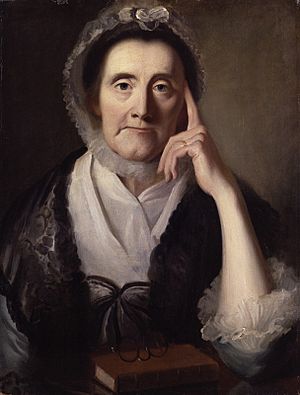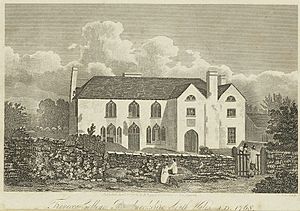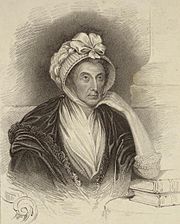Selina Hastings, Countess of Huntingdon facts for kids
Quick facts for kids
The Countess of Huntingdon
|
|
|---|---|
 |
|
| Personal details | |
| Born |
Selina Shirley
24 August 1707 Astwell Castle, Northamptonshire, England |
| Died | 17 June 1791 (aged 83) |
| Spouse |
Theophilus Hastings, 9th Earl of Huntingdon
(m. 1728; died 1746) |
| Children |
|
| Parents | Washington Shirley, 2nd Earl Ferrers Mary Levinge |
| Known for | Methodism |
Selina Hastings, Countess of Huntingdon (born August 24, 1707 – died June 17, 1791) was an important English religious leader. She played a big part in the Christian revival of the 1700s. She was also key to the Methodist movement in England and Wales.
Selina founded a special branch of Methodism. It was known as the Countess of Huntingdon's Connexion. This group spread in England and even in Sierra Leone.
She helped pay for and guide early Methodism. In 1768, she became the first leader of Trevecca College in Wales. This college trained Methodist ministers. She built 64 chapels across England and Wales. She also supported mission work in America. It's thought she spent over £100,000 on these projects. This was a huge amount of money back then!
Selina often wrote to famous religious leaders like George Whitefield and John Wesley. She is also remembered for her strong opinions.
Contents
Early Life and Family
Selina Shirley was born in August 1707. Her birthplace was Astwell Castle in Northamptonshire, England. She was the second daughter of Washington Shirley, 2nd Earl Ferrers. Her mother was Mary Levinge.
When she was 17, her family moved to Staunton Harold Hall. In 1728, she married Theophilus Hastings, 9th Earl of Huntingdon. His home was Donington Hall, nearby. This marriage was arranged by his half-sister, Lady Elizabeth Hastings. Lady Elizabeth was known for helping others and supporting women's education.
Selina had seven children in the first ten years of her marriage. Sadly, four of them died young. Her husband passed away in 1746. Selina herself often had poor health. Her family was interested in politics, religion, and art. They often had portraits painted by popular artists.
Helping the Foundling Hospital
In 1730, Selina became one of 21 noblewomen who supported Thomas Coram. He was trying to start the Foundling Hospital. This hospital was for abandoned children. Having women like Lady Huntingdon sign his petition made the project very respected. Many of these women signed even when their husbands had refused. This made the Foundling Hospital a very popular charity.
Selina also gave money to Coram. This money helped pay for fees and other costs. These costs were for getting the hospital's official charter approved by the King. The petition was given to King George II in 1735.
Her Religious Journey
In 1739, Lady Huntingdon joined the first Methodist group in London. After her husband died in 1746, she fully joined John Wesley and George Whitefield. They were working on a big religious revival.
It was Wesley who first drew her to Methodism. She visited his chapel in Donnington. There, she was given a special private pew, which was unusual. Whitefield became her personal chaplain. With his help, she started the "Countess of Huntingdon's Connexion." This was a Calvinistic movement within Methodism. She preferred not to leave the Anglican Church, but faced problems from its clergy.
Many important people were her friends. These included Isaac Watts and Philip Doddridge. Lady Anne Erskine was her closest friend for many years.
Building Chapels
In 1748, Lady Huntingdon gave Whitefield a scarf. This showed he was her chaplain. He then preached in her London home to important people. These included famous figures like Lord Chesterfield. She also held large dinner parties. Whitefield would preach to the guests after they ate.
She wanted to help the religious revival grow. She especially liked Whitefield's Calvinistic style. She founded 64 chapels and helped fund others. She insisted that all her chapels follow the Church of England's teachings. They also had to use only the Book of Common Prayer.
Some of her chapels were in Brighton (1761) and Bath (1765). She also built several in Wales. In London, she founded one next to her home. This led to a legal case with the local church. She also partly funded the Surrey Chapel, Southwark. She appointed ministers to preach in her chapels. She believed that as a noblewoman, she could hire as many chaplains as she wished.
In her Bath chapel, there was a special curtained area. It was called "Nicodemus' Corner." Bishops would sit there secretly to listen to the services.
Trevecca College and Its History

In 1768, six Methodist students were expelled from St Edmund Hall, Oxford. After this, the Countess started a college to train ministers. It was at Trefeca (Trevecca) in Mid Wales. George Whitefield preached at its opening.
The college later moved to Hertfordshire in 1792. It was renamed Cheshunt College. In 1906, it moved to Cambridge. Cheshunt College later joined with Westminster College, Cambridge in 1967.
In 1842, the Presbyterian Church of Wales opened its own college. This college was also at Trefeca. It was about a quarter mile from the Countess's original site.
Supporting Missions Abroad

The Countess was interested in the Thirteen Colonies in America. She also cared about Native Americans and enslaved Africans there. In the mid-1760s, she met Mohegan preacher Samson Occom. He was visiting England to raise money for missions to Native Americans.
In 1770, she became responsible for Whitefield's overseas estates. These were in Georgia and South Carolina. They included the Bethesda Home for Boys. Following Whitefield's advice, she acquired more enslaved people to help the orphanage.
The Countess supported the writings of formerly enslaved Africans. She helped publish books by Ukawsaw Gronniosaw and Olaudah Equiano.
She also used her influence to help Phillis Wheatley. Wheatley was an enslaved African poet. In 1773, the Countess helped publish Wheatley's book of poems. The book was dedicated to the Countess. They never met because the Countess was ill. However, they did write letters to each other.
Until 1779, Lady Huntingdon and her chaplains were part of the Church of England. Most Methodists were still connected to it. That year, a court stopped her chaplains from preaching in a London building. To get around this, she used the Act of Toleration 1689. This meant her group was classified as "dissenters." Some important members left because they did not want this status.
After the American War of Independence, the British helped thousands of formerly enslaved Africans. These people had joined the British side. They were called Black Loyalists. About 3,000 were settled in Nova Scotia and New Brunswick. The Countess sent missionaries to these colonies. They included John Marrant and William Furmage. They helped the Black Loyalists.
Her Lasting Impact
Lady Huntingdon managed her chapels and chaplains very actively. She was quite strict. She even complained to King George III about the Archbishop's lifestyle. She also strongly protested against changes in Methodist teachings.
When she died in 1791, her 64 chapels and the college went to four trustees. One of them was Lady Ann Erskine. Lady Ann lived in Lady Huntingdon's house. She handled all the huge amount of correspondence. She did this faithfully until her own death in 1804.
The main trustee was Reverend Thomas Haweis. He led the Connexion, which had about 120 chapels. He made sure the Connexion stayed as close to the Church of England as possible. Many chapels later joined the Free Church of England in 1863.
One of the first changes after her death was moving the college. In 1792, it moved to Cheshunt, Hertfordshire. It was known as Cheshunt College. It moved again in 1905 to Cambridge University. The college was famous for sending many men to missions abroad.
In 1795, her Spa Fields Chapel was used to start the Missionary Society. This later became the London Missionary Society. After her death, much of her movement joined the Congregationalist Church. In 2022, there were still 22 Connexion churches in England. Others were in Sierra Leone.
In her will, she asked that no biography be written about her. So, none was tried until 90 years after she died. However, people wrote tributes. Horace Walpole called her "the patriarchess of the Methodists." John Henry Newman said she "devoted herself, her means, her time, her thoughts, to the cause of Christ." She was clearly a very important person in the Evangelical Revival.
Places Named After Her
- Huntingdon College in Montgomery, Alabama, is named after her. It honors her contributions to Methodism.
- Huntingdon Street in Savannah, Georgia, is also named for her. This is because of her connection to Whitefield and John and Charles Wesley. They did religious work in the Colony of Georgia.
- Lady Huntingdon Lane is at the Givens Estates in Asheville, North Carolina. This is a retirement community linked to the United Methodist Church.
- Lady Huntingdon Road is at the United Methodist Assembly, Lake Junaluska, NC. It is near the World Methodist Center.
- Huntingdon, the county seat of Huntingdon County, Pennsylvania, is named for her. It was founded in 1787.
Her Children
Selina had seven children with her husband, Theophilus Hastings. Three of them died when they were young. The date of death for a fourth child is not known. Her children who lived the longest were:
- Francis, Lord Hastings (1729–1789). He became the 10th Earl of Huntingdon. He never married and had no children.
- Lady Elizabeth Hastings (1731–1808). She was the only child to live longer than her mother. She married John Rawdon, 1st Earl of Moira.
- Lady Selina Hastings (1737–1763). She died while engaged and had no children.
See also
- Methodist Church of Great Britain
- Countess of Huntingdon's Connexion


